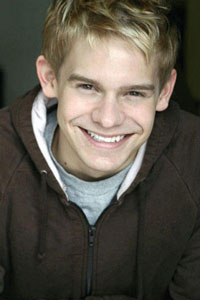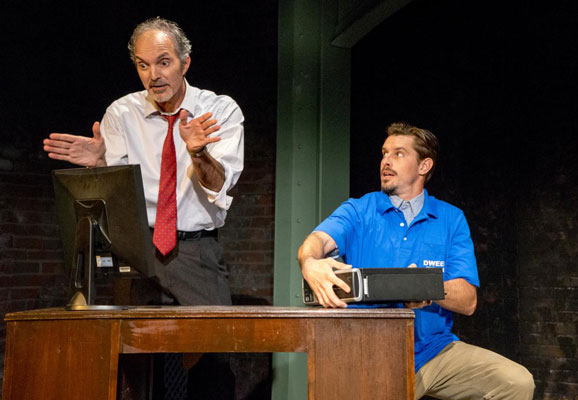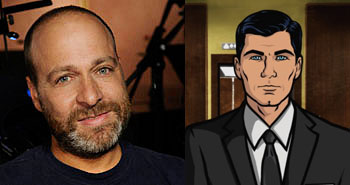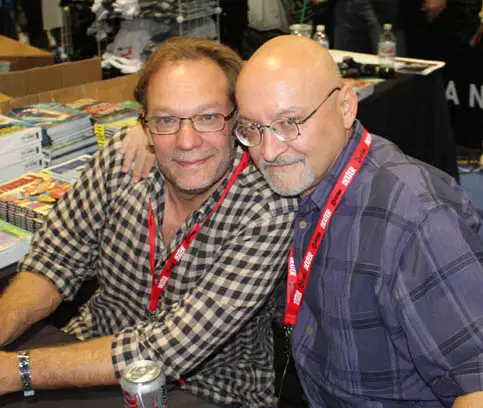
There’s a great new show about to come to air AMC called The Walking Dead.
It follows a group of survivors after a zombie apocalypse who are in search of a safe and secure home.
The show is based on the comic of the same name and it’s got some powerhouse talent behind it; namely Frank Darabont, Gale Anne Hurd and make-up & effects wizard Greg Nicotero.
I talked with Frank and Greg at Comic-Con (in a round-table interview) about the show, the actors and all things Zombie!
For the full interview, click onto the audio link above or download from iTunes.
As the interview starts, Frank and Greg look at all the recorders in front of them…
Frank Darabont: They’re closing in like Zombies, these things.
[LAUGHTER]
Greg Nicotero: If they start moving closer and closer, I’m gone.
Frank: Yeah, I’m the first out the door.
We’re going to pick your brains, not eat them.
Greg: Our zombies don’t eat brains. That’s a fallacy.
Frank: That’s a big myth from Return of the Living Dead. Dan O’Bannon and those folks have completely skewed the perception of what a zombie actually is and does.
Greg: And the irony was as a shoot gift AMC handed hats to the whole crew and it said, “I Heart Brains” on it. [LAUGHTER] I looked at it and Frank and I went, “Wrong show!” [LAUGHTER] It was really nice but I’m not wearing that hat.
Frank: Wrong zombies. [LAUGHTER] I love Return of the Living Dead though. It was fun.
So are your zombies different in any other way?
Frank: I’m trying to think. No, not really. This is really old school Book of Genesis, Night of the Living Dead, kind of zombies. I’m not that keen on revisionism, as a rule. Unless we’re talking Westerns. That’s a whole different subject. [LAUGHTER]
But, no, we’re kind of thrown back to the good old days. I mean, I guess the keenest, cleverist, sort-of revisionist, zombie thing isn’t really even a zombie thing–is 28 Days Later, which I adored. But, no, we’re the good, old lurching, drooling, George Romero mindset on this thing.
Greg: Well, George really set-up the rules. It’s kind of funny because I was talking to someone earlier and I said, “You know, if there really was a zombie outbreak we’ve no idea if shooting them in the head would kill them.” [LAUGHTER] Everyone just assumes, “Yeah, you shoot ’em in the head…” because George made those rules up. You cut the head off, separate the head and it’s done. So, we could be in big trouble if it really ever happens.
But we had a three day zombie school where we auditioned everybody’s zombie walk. And Frank and I talked a lot about the holy grail of zombie sequences and it’s the cemetery scene in the original Night of the Living Dead. Because you see Bill Hinzman (Director of Photography on the original film) in the background and he’s moving and lurching but when he attacks he gets into a bit of a frenzy so it’s not slow and lumbering, they become threatening and aggressive and scary.
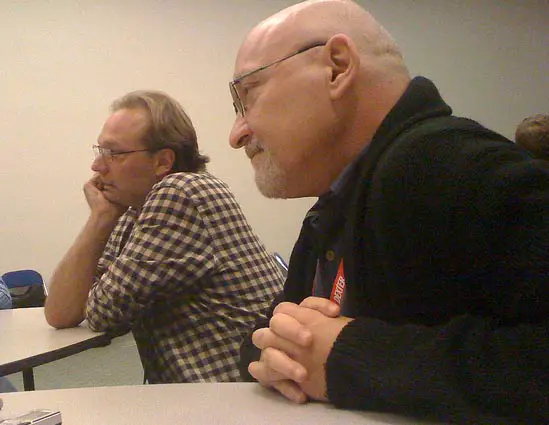
Frank: And somewhat fast. Not like Jesse Owens at the Munich Olympics fast. Not like Zack Snyder or Danny Boyle fast but that son of bitch is kind-of moving along pretty good.
I always got such a big kick out of the incessant endless internet debate: fast zombies versus slow zombies. The slow zombie contingent always claim that zombies don’t run. It’s like–have you seen Night of the Living Dead? [LAUGHTER] That son of a bitch–that first zombie–is running. He’s moving pretty fast.
So, Greg and I really–from the get-go–said, as far as zombie speed is concerned, of course they can run but let’s limit it to, obviously, when they are in a frenzy. Because many times they’re not. The way we read this is that they are fundamentally mindless and, indeed, do a lot of standing around and staring at nothing. But they are predatory and when–like any animal when riled to that state– by hunger, aggression, whatever…yeah, they get dangerous and they move faster. And I think you look at Romero’s oeuvre and it bares us out.
Because you can’t just have zombies shuffling along like the mummy–you remember the old jokes about the mummy? If you can’t out run the mummy you deserve to die. [LAUGHTER] I mean, it’s true.
You talked about being on AMC and there being some advantage to not having a completely wide open freedom of like an HBO and that you really haven’t run into any obstruction to stuff you want to get into the show.
Frank: Yeah. I’m not experiencing any constraints here, and we’re doing some pretty edgy stuff. To the point where, at times, when we’re shooting some of this stuff I’m thinking, “I can’t believe they’re going to let us put this on television!” I mean, I don’t want to make it sound like, like some snuff film where puppies are being clubbed by sledgehammers.
I guess the bottom line is in terms of how we want to depict something in the show that we’re doing. Whether we want to do creatively less is more or whether we want to do more is more. Because, this deserves to be more of a Romero kind of moment or a Nicotero kind of moment. We’re making those decisions based upon how we feel like shooting the thing and not based on what we can and cannot do.
Greg: It’s funny because, in an effort to streamline… I’ve done a lot of zombie films and we know there’s going to be big zombie days and we know that zombies are going to get shot in the head. One of the things that George never had to worry about in Dawn of the Dead was you could strap a squib on an extra and nobody ever cared. You just have an extra walking through the Monroeville Mall–boom! Shoot him and they would drop. So, of course, the laws changed and now it has to be a stunt person. So, one of the things we came up with was this little rig that we could strap on any of the extras that was a good exit-wound blood-spray. And it was one of those things where it’s not an explosive so we don’t have to worry about hurting anybody–it’s safe. We came up with this little rig that basically runs a big tube off to a little foot peddle. The zombie would walk up and you’d step on the thing and the blood would shoot out and it worked really well. There was one day we were shooting with Frank and Frank’s like, “That was so George Romero. I loved it!” and he’s like, “Put more blood in!” So, I was like, “Well, ok…sure.”
You know, that’s part of the fun–seeing the blood spray and the reaction. And then there are other scenes where, if Rick’s (Andrew Lincoln) running through a crowd of zombies and the camera’s following him and it’s boom, boom, boom and people will be dropping then there will be those shots, editorially, they might add a little CG blood spray here or there. That’s obviously a factor of the way the shot is being, you know, composed and how it’s being directed.

What do the zombies stand for? Are they metaphorical or are they just dead people walking?
Frank: To me they’re just dead people walking around. I mean, of course they’re metaphorical–not to be glib about the answer–of course they are, but it feels, to me, like those metaphors have been covered by filmmakers. The giants upon who’s shoulders we stand. They’ve kind-of laid those metaphors out through decades of these films–particular George Romero. I don’t know that I’m going to bring any thing new to those metaphors, as a film-maker. So, my focus is really on the human part of the story. We’ll certainly find metaphors as we go. That’s one of the wonderful things about the creative process–is that you find if you care about what you’re doing you find yourself saying things as you develop a script or as you‘re finalizing the pages as you are in the creative process you go, “Oh, wow, this is–this episode kind of turned out to be a little bit about this hidden thematic thing,” and that’s great. But it’s not like we have a set agenda of, you know, metaphorical touch points going into this thing. I think that stuff will come naturally out of it.
And then there’s my favorite part of what we do which is–it doesn’t matter what we think the metaphors are–what’s interesting is what you all think the metaphors are. It’s what the audience brings to it and the fans bring to it. I’ve heard so many wonderful interpretations on all of my things, or aspects of things I’ve done, that never even occurred to me. I’ll get that feedback and I’ll think, “Yeah, that’s cool!”
Greg: But, you know, in this show–we don’t have the Santa Claus zombie, we don’t have the priest zombie, we don’t have the policeman or the cheerleader zombie. George always added that satirical aspect of–“oh, there’s a nurse, there’s this.” You know, like the butcher who still has his meat cleaver in his hand when he is walking around, but, you know, that was like…
Frank: None of these people were hearing that the world was falling apart… “Oh, no, I think I need to go to cheerleading practice because, apparently, there’s this horrible outbreak of something and–but I can’t miss that cheerleading–or my bowling league.” It’s like, “What? Are you crazy?” You know, George got away with it because he is George and that was his thing. And there was something about seeing a clown zombie and that was funny.
Greg: That’s not what our zombies represent. They’re just every day people that you don’t need their clothing to define who they are. They’re part of this massive horde of carnivorous creatures that are going to eat. They’re starving to death. You figure, you put all of us in this room and you leave us in here long enough. We’ll start eating whatever we need to eat.
Frank: That’s right. I’m always trying to pin this to the idea of reality because I did get a lot of questions like that. It’s like, “Oh! We could have a ballerina zombie!” and it’s like, “No!” Put your head where it needs to be because if there’s hurricane Katrina nobody’s going to ballet practice. [LAUGHTER] If there’s a fucking earthquake in Los Angeles where serious buildings fall over and there’s a civil emergency and lives are in danger nobody’s going to hockey practice. Nobody’s going, you know. Put that back story in your heads and then tell me what these zombies look like. That’s been very important to me because I want to take the premise seriously and not make light of it.

